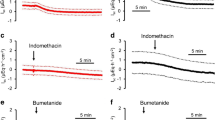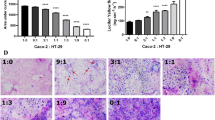Abstract
Introduction
It is recognized that epithelial ion transport depends on oxygen supply, but this dependence has not been characterized in the human colon in vitro despite its surgical and clinical implications.
Purposes
The aim of this study is to measure the oxygen consumption of colonic epithelium under conditions which preserve vectorial ion transport and to assess the sensitivity of the human colonic epithelium short-circuit current (I sc) to acute hypoxia induced in vitro.
Methods
Isolated mucosa preparations from human sigmoid colon were placed in a modified Ussing chamber which allows simultaneous measurement of short-circuit current (I sc) and oxygen consumption (QO2). In separate experiments, the sensitivity to acute hypoxia induced in a conventional Ussing chamber was assessed.
Results
Basal mean ± SEM values (n = 8) were I sc = 3.3 ± 0.5 μEq h−1 cm−2 and QO2 = 8.09 ± 0.55 μmol h−1 cm−2. The contribution of the serosal side to the oxygen supply was higher than that of the mucosal side (p = 0.0023). Ouabain reduced I sc by 70% (P < 0.0001) and QO2 by 26% (n = 8; P = 0.0009), suggesting that a large fraction of QO2 is needed to support ouabain-sensitive electrogenic transport. Induction of hypoxia at both sides of the Ussing chamber caused a rapid decrease in I sc after 2 min. I sc was also significantly depressed when hypoxia was induced by 5 min in the serosal side (n = 6, P < 0.0001), but was unaffected by hypoxia induced in the mucosal side.
Conclusion
The present results allow a better understanding of the clinical consequences of acute hypoxia on intestinal ion transport.





Similar content being viewed by others
Abbreviations
- I sc :
-
Short-circuit current
- PD:
-
Transepithelial potential difference
- QO2 :
-
Epithelial oxygen consumption
- R te :
-
Transepithelial resistivity
References
Guebel DV, Torres NV (2008) A computer model of oxygen dynamics in human colon mucosa: implications in normal physiology and early tumor development. J Theor Biol 250(3):389–409
Barlow B, Santulli TV (1975) Importance of multiple episodes of hypoxia or cold stress on the development of enterocolitis in an animal model. Surgery 77(5):687–690
Petrosyan M, Guner YS, Williams M, Grishin A, Ford HR (2009) Current concepts regarding the pathogenesis of necrotizing enterocolitis. Pediatr Surg Int 25(4):309–318
Kazez A, Küçükaydin N, Küçükaydin M, Kontaş O, Okur H, Doğan P (1997) A model of hypoxia-induced necrotizing enterocolitis: the role of distension. J Pediatr Surg 32(10):1466–1469
Meyer KF, Martins JL, Freitas Filho LG et al (2006) Evaluation of an experimental model of necrotizing enterocolitis in rats. Acta Cir Bras 21(2):113–118
Gallavan RH Jr, Parks DA, Jacobson ED (1989) Pathophysiology of gastrointestinal circulation. In: Wood JD (ed) Handbook of physiology, section 6: the gastrointestinal system, vol 1, Part 2. American Physiological Society, Bethesda, pp 1713–1732
MacDonald PH (2002) Ischaemic colitis. Best Pract Res Clin Gastroenterol 16(1):51–61
van Haren FM, Sleigh JW, Pickkers P, Van der Hoeven JG (2007) Gastrointestinal perfusion in septic shock. Anaesth Intensive Care 35(5):679–694
Ratnaraj J, Kabon B, Talcott MR, Sessler DI, Kurz A (2004) Supplemental oxygen and carbon dioxide each increase subcutaneous and intestinal intramural oxygenation. Anesth Analg 99(1):207–211
Benaron DA, Parachikov IH, Friedland S et al (2004) Continuous, noninvasive, and localized microvascular tissue oximetry using visible light spectroscopy. Anesthesiology 100(6):1469–1475
Leung FW (2008) Endoscopic reflectance spectrophotometry and visible light spectroscopy in clinical gastrointestinal studies. Dig Dis Sci 53(6):1669–1677
Hoff DA, Gregersen H, Hatlebakk JG (2009) Mucosal blood flow measurements using laser Doppler perfusion monitoring. World J Gastroenterol 15(2):198–203
Kunzelmann K, Mall M (2002) Electrolyte transport in the mammalian colon: mechanisms and implications for disease. Physiol Rev 82(1):245–289
Binder HJ (2003) Intestinal fluid and electrolyte movement. In: Boron WF, Boulpaep EL (eds) Medical physiology. Saunders, Philadelphia, pp 931–946
Edmonds CJ, Marriott J (1968) Electrical potential and short-circuit current of an in vitro preparation of rat colon mucosa. J Physiol 194(2):479–494
Lew VL (1970) Short-circuit current and ionic fluxes in the isolated colonic mucosa of Bufo arenarum. J Physiol 206(3):509–528
Saraví FD, Saldeña TA, Cincunegui LM (1996) Colon epithelial electrical responses to acute hypoxia and reoxygenation. Acta Gastroenterol Latinoam 26(3):159–165
Mandel LJ, Balaban RS (1981) Stoichiometry and coupling of active transport to oxidative metabolism in epithelial tissues. Am J Physiol 240(5):F357–F371
Roediger WE (1980) Role of anaerobic bacteria in the metabolic welfare of the colonic mucosa in man. Gut 21(9):793–798
Ardawi MS, Newsholme EA (1985) Fuel utilization in colonocytes of the rat. Biochem J 231(3):713–719
Fleming SE, Fitch MD, DeVries S, Liu ML, Kight C (1991) Nutrient utilization by cells isolated from rat jejunum, cecum and colon. J Nutr 121(6):869–878
Latella G, Caprilli R (1991) Metabolism of large bowel mucosa in health and disease. Int J Colorectal Dis 6(2):127–132
Del Castillo JR, Ricabarra B, Sulbarán-Carrasco MC (1991) Intermediary metabolism and its relationship with ion transport in isolated guinea pig colonic epithelial cells. Am J Physiol 260(3 Pt 1):C626–C634
Durand J, Durand-Arczynska W, Wankmiller D (1988) Coupling of active sodium transport to oxidative metabolism in rabbit distal colon. J Physiol 396(1):55–64
Saraví FD, Saldeña TA, Carrera CA, Ibañez JE, Cincunegui LM, Carra GE (2003) Oxygen consumption and chloride secretion in rat distal colon isolated mucosa. Dig Dis Sci 48(9):1767–1773
Saraví FD, Cincunegui LM, Saldeña TA, Carra GE, Ibáñez JE (2005) Increased oxygen consumption caused by cAMP- and Ca2+-mediated chloride secretion in rat distal colon. Acta Gastroenterol Latinoam 35(1):13–18
Stack WA, Filipowicz B, Hawkey CJ (1996) Nitric oxide donating compounds stimulate colonic ion transport in vitro. Gut 39(1):93–99
McNamara B, Winter DC, Cuffe JE, O’Sullivan GC, Harvey BJ (1999) Basolateral K+ channel involvement in forskolin-activated chloride secretion in human colon. J Physiol 519(1):251–260
Taylor J, Hamilton KL, Butt AG (2001) HCO −3 potentiates the cAMP-dependent secretory response of the human distal colon through a DIDS-sensitive pathway. Pflügers Arch Eur J Physiol 442(2):256–262
Suarez F, Furne J, Springfield J, Levitt M (1997) Insights into human colonic physiology obtained from the study of flatus composition. Am J Physiol 272(5):G1028–G1033
Sahakian AB, Jee SR, Pimentel M (2010) Methane and the gastrointestinal tract. Dig Dis Sci 55(8):2135–2143
Saraví FD, Saldeña TA, Cincunegui LM, Carra GE (1997) Asymmetrical oxygen availability from serosal and luminal sides of rat distal colon epithelium. Rev Esp Fisiol 53(4):367–375
Parsons DS, Powis G (1971) Some properties of a preparation of rat colon perfused in vitro through the vascular bed. J Physiol 217(3):641–663
Bruewer M, Samarin S, Nusrat A (2006) Inflammatory bowel disease and the apical junctional complex. Ann NY Acad Sci 1072:242–252
Shen L, Weber CR, Raleigh DR, Yu D, Turner JR (2011) Tight junction pore and leak pathways: a dynamic duo. Annu Rev Physiol 73:283–309
Anand RJ, Leaphart CL, Mollen KP, Hackam DJ (2007) The role of the intestinal barrier in the pathogenesis of necrotizing enterocolitis. Shock 27(2):124–133
Lin PW, Nasr TR, Stoll BJ (2008) Necrotizing enterocolitis: recent scientific advances in pathophysiology and prevention. Semin Perinatol 32(2):70–82
Taylor CT, Colgan SP (2007) Hypoxia and gastrointestinal disease. J Mol Med 85(12):1295–1300
Acknowledgments
The authors thank the collaboration and advice of Dr. Rolando Valent, Dr. Héctor Viotti, and Dr. Dino Sánchez De Simone from the Hospital Español and of Prof. Daniel Matus and Dr. Francisco Bettalemi from the Hospital Militar of Mendoza. This work was funded by a grant from the National University of Cuyo (Secretaría de Ciencia, Técnica y Posgrado).
Author information
Authors and Affiliations
Corresponding author
Rights and permissions
About this article
Cite this article
Carra, G.E., Ibáñez, J.E. & Saraví, F.D. Electrogenic transport, oxygen consumption, and sensitivity to acute hypoxia of human colonic epithelium. Int J Colorectal Dis 26, 1205–1210 (2011). https://doi.org/10.1007/s00384-011-1215-7
Accepted:
Published:
Issue Date:
DOI: https://doi.org/10.1007/s00384-011-1215-7




